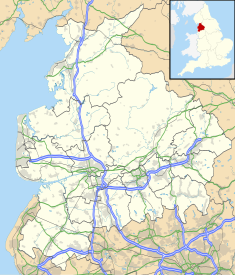| Hackensall Hall | |
|---|---|
 The building in 2011, looking south | |
| Location | Whinny Lane, Preesall, Lancashire, England |
| Coordinates | 53°55′14″N2°59′35″W / 53.92057°N 2.99317°W |
| Area | Borough of Wyre |
| Built | 1873 |
Listed Building – Grade II | |
| Designated | 3 October 1984 |
| Reference no. | 1361845 |
Hackensall Hall, also known as Hackensall Hall Farmhouse, is a historic building on Whinny Lane in Preesall, Lancashire, England. It is Grade II listed, built in 1873. [1]
Contents
A remodelling of a 17th-century house, it retains much of its earlier fabric. It is in pebbledashed brick with sandstone dressings and a slate roof, and has two storeys with attics. The house has an irregular plan with rear wings and outshuts. Most of the windows are mullioned and transomed, or mullioned. Other features include a single-storey gabled porch, a doorway with a moulded surround and a Tudor arched head, and a re-set inscribed plaque. Inside the house is an inglenook. [2] [1]
Francis Fleetwood, brother of Richard, built Hackensall Hall in 1656 after their home at Rossall Hall was flooded. [3] Nearby Parrox Hall was built about the same time, and has been in the possession of the Elletson family since 1690. [4]






